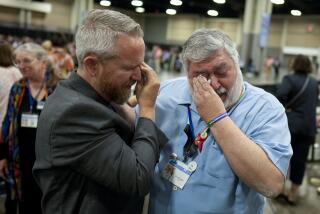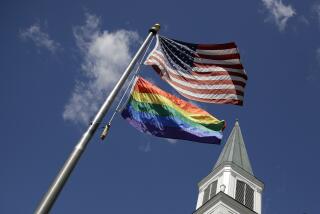Seeking Functional Cohesion : Protestants Achieve a Unity Path Milestone
- Share via
NEW YORK — That long, zigzag road of trying to achieve greater unity among a big swath of American Protestantism has passed another milestone, taking a new route toward the goal.
It no longer intends structural merger--as was originally contemplated and which has proved the typical bottleneck to unifying churches--but nevertheless aims at functional cohesion.
This time, “I think it’s going to fly,” said the Rev. David W. A. Taylor of Princeton, N.J., general secretary of the Consultation on Church Union. “After 26 years of work, we’ve now got a plan before the churches.”
Taylor, a Presbyterian, said in a telephone interview that the plan is “workable and realistic” and he predicted that the involved denominations will approve it. “No question about it, I fully believe they will.”
Unanimous Agreement
The plan was recommended unanimously at a meeting early this month in New Orleans of the consultation, involving about 200 representatives of nine denominations totaling more than 22 million members.
“This is the time we have been working and praying for,” said the Rev. Gerald F. Moede, a United Methodist pastor in Adell, Wis. As the consultation’s former general secretary, he was a chief architect of the plan.
It is termed “covenanting” and envisages mutual recognition by the denominations of one another’s baptism, membership and clergy, allowing intercommunion and joint ministry, mission and service.
Moede called the plan a “biblical format to bring Christians together sociologically and theologically to meet today’s needs and those of the future.”
It does not necessitate overhauling and meshing organizational structures--usually blocked by power rivalries--but continues the present structures, providing for working partnership and mutual interflow of personnel.
Unity, Not Uniformity
“What we have been seeking since the beginning is not uniformity but unity in things that really matter, like membership and ministry and mission,” said the Rev. George H. Pike of Louisville, Ky., a Presbyterian.
The consultation previously had recommended a plan of structural union, but that 1970 plan soon was dropped after it ran into widespread opposition.
That setback followed eight years of work by the consultation, which was launched in 1962 after the late Presbyterian leader Eugene Carson Blake urged a unified church that was catholic, reformed and evangelical.
Seconded by the late Episcopal Bishop James Pike, Blake’s proposal at an assembly of the National Council of Churches unleashed an ensuing tide of support--and sparked formation of the consultation.
The nine denominations participating in it are the United Methodist, Episcopal and Presbyterian churches, the Christian Church (Disciples of Christ), United Church of Christ, International Council of Community Churches and three predominantly black Methodist denominations, the African Methodist Episcopal Church, African Methodist Episcopal Zion Church and Christian Methodist Episcopal Church.
Took a New Tack
After the plan for structural merger collapsed, the consultation took a new tack, working on a theological consensus, with an agreement reached on it in 1984.
Six of the nine denominations have accepted the theological agreement as a basis for the next step toward an operational covenant, and two denominations--the United Church of Christ and the Disciples of Christ--are yet to act on the agreement in 1989.
The ninth denomination, the Episcopal Church, at its 1988 convention commended parts of the agreement, but said some points needed clarification.
That reworking, done by a drafting committee headed by the Rev. Paul A. Crow Jr. of Indianapolis, the Disciples’ ecumenical officer, was the document unanimously approved at the New Orleans meeting.
Pike, then the consultation’s outgoing president, called the approval a “historic moment.”
‘Pentecostal Experience’
United Methodist Bishop William Boyd Grove of Charleston, W.Va., commented, “We are on the threshold of a new Pentecostal experience of the unity of the church.”
Action by the nine churches is not expected to be complete before the mid-1990s, since conventions of the denominations are held at varying intervals.
African Methodist Episcopal Bishop Vinton R. Anderson of St. Louis was elected president of the consultation, succeeding Pike.
Taylor, who replaced Moede as consultation general secretary three months ago, said, “We believe we are being led by God in a new way that has implications far beyond these nine churches--the unity of the holy catholic church.”
More to Read
Sign up for Essential California
The most important California stories and recommendations in your inbox every morning.
You may occasionally receive promotional content from the Los Angeles Times.













